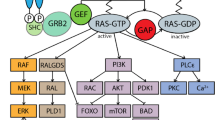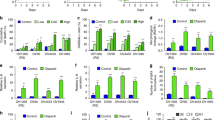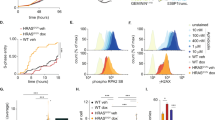Abstract
Approximately 20% of tumors contain activating mutations in the RAS family of oncogenes. As tumors progress to higher grades of malignancy, the expression of oncogenic RAS has been reported to increase, leading to an oncogene-induced senescence (OIS) response. Evasion of this senescence barrier is a hallmark of advanced tumors indicating that OIS serves a critical tumor-suppressive function. Induction of OIS has been attributed to either RAS-mediated production of reactive oxygen species (ROS) or to induction of a DNA damage response (DDR). However, functional links between these two processes in triggering the senescent phenotype have not been explicitly described. Our previous work has shown that, in cultured untransformed cells, preventing elimination of oxidized guanine deoxyribonucleotides, which was achieved by suppressing expression of the cellular 8-oxo-dGTPase, human MutT homolog 1 (MTH1), sufficed to induce a DDR as well as premature senescence. Here, we demonstrate that overexpression of MTH1 can prevent the oncogenic H-RAS-induced DDR and attendant premature senescence, although it does not affect the observed elevation in ROS levels produced by RAS oncoprotein expression. Conversely, we find that loss of MTH1 preferentially induces an in vitro proliferation defect in tumorigenic cells overexpressing oncogenic RAS. These results indicate that the guanine nucleotide pool is a critical target for intracellular ROS produced by oncogenic RAS and that RAS-transformed cells require robust MTH1 expression to proliferate.
This is a preview of subscription content, access via your institution
Access options
Subscribe to this journal
Receive 50 print issues and online access
$259.00 per year
only $5.18 per issue
Buy this article
- Purchase on Springer Link
- Instant access to full article PDF
Prices may be subject to local taxes which are calculated during checkout




Similar content being viewed by others
References
Algarra I, Perez M, Serrano MJ, Garrido F, Gaforio JJ . (1998). c-K-ras overexpression is characteristic for metastases derived from a methylcholanthrene-induced fibrosarcoma. Invasion Metastasis 18: 261–270.
Bartkova J, Rezaei N, Liontos M, Karakaidos P, Kletsas D, Issaeva N et al. (2006). Oncogene-induced senescence is part of the tumorigenesis barrier imposed by DNA damage checkpoints. Nature 444: 633–637.
Benanti JA, Galloway DA . (2004). Normal human fibroblasts are resistant to RAS-induced senescence. Mol Cell Biol 24: 2842–2852.
Buchholz M, Braun M, Heidenblut A, Kestler HA, Kloppel G, Schmiegel W et al. (2005). Transcriptome analysis of microdissected pancreatic intraepithelial neoplastic lesions. Oncogene 24: 6626–6636.
Di Micco R, Fumagalli M, Cicalese A, Piccinin S, Gasparini P, Luise C et al. (2006). Oncogene-induced senescence is a DNA damage response triggered by DNA hyper-replication. Nature 444: 638–642.
Dimri G, Lee X, Basile G, Acosta M, Scott G, Roskelley C et al. (1995). A biomarker that identifies senescent human cells in culture and in aging skin in vivo. Proc Natl Acad Sci USA 92: 9363–9367.
Elenbaas B, Spirio L, Koerner F, Fleming MD, Zimonjic DB, Donaher JL et al. (2001). Human breast cancer cells generated by oncogenic transformation of primary mammary epithelial cells. Genes Dev 15: 50–65.
Gackowski D, Kruszewski M, Bartlomiejczyk T, Jawien A, Ciecierski M, Olinski R . (2002). The level of 8-oxo-7,8-dihydro-2′-deoxyguanosine is positively correlated with the size of the labile iron pool in human lymphocytes. J Biol Inorg Chem 7: 548–550.
Garber ME, Troyanskaya OG, Schluens K, Petersen S, Thaesler Z, Pacyna-Gengelbach M et al. (2001). Diversity of gene expression in adenocarcinoma of the lung. Proc Natl Acad Sci USA 98: 13784–13789.
Haghdoost S, Sjolander L, Czene S, Harms-Ringdahl M . (2006). The nucleotide pool is a significant target for oxidative stress. Free Radic Biol Med 41: 620–626.
Irani K, Xia Y, Zweier JL, Sollott SJ, Der CJ, Fearon ER et al. (1997). Mitogenic signaling mediated by oxidants in Ras-transformed fibroblasts. Science 275: 1649–1652.
Kasai H, Nishimura S . (1984). Hydroxylation of deoxyguanosine at the C-8 position by ascorbic acid and other reducing agents. Nucleic Acids Res 12: 2137–2145.
Kasid A LM, Papageorge AG, Lowy DR, Gelmann EP . (1985). Transfection of v-rasH DNA into MCF-7 human breast cancer cells bypasses dependence on estrogen for tumorigenicity. Science 228: 725–728.
Kawanishi S, Hiraku Y, Oikawa S . (2001). Mechanism of guanine-specific DNA damage by oxidative stress and its role in carcinogenesis and aging. Mutat Res 488: 65–76.
Kruszewski M . (2003). Labile iron pool: the main determinant of cellular response to oxidative stress. Mutat Res 531: 81–92.
Lee AC, Fenster BE, Ito H, Takeda K, Bae NS, Hirai T et al. (1999). Ras proteins induce senescence by altering the intracellular levels of reactive oxygen species. J Biol Chem 274: 7936–7940.
Mallette FA, Gaumont-Leclerc M-F, Ferbeyre G . (2007). The DNA damage signaling pathway is a critical mediator of oncogene-induced senescence. Genes Dev 21: 43–48.
Mitsushita J, Lambeth JD, Kamata T . (2004). The superoxide-generating oxidase Nox1 is functionally required for Ras oncogene transformation. Cancer Res 64: 3580–3585.
Moiseeva O, Bourdeau V, Roux A, Deschenes-Simard X, Ferbeyre G . (2009). Mitochondrial dysfunction contributes to oncogene-induced senescence. Mol Cell Biol 29: 4495–4507.
Nakabeppu Y . (2001). Molecular genetics and structural biology of human MutT homolog, MTH1. Mutat Res 477: 59–70.
Quintanilla M, Brown K, Ramsden M, Balmain A . (1986). Carcinogen-specific mutation and amplification of Ha-ras during mouse skin carcinogenesis. Nature 322: 78–80.
Radisky DC, Levy DD, Littlepage LE, Liu H, Nelson CM, Fata JE et al. (2005). Rac1b and reactive oxygen species mediate MMP-3-induced EMT and genomic instability. Nature 436: 123–127.
Rai P, Onder TT, Young JJ, McFaline JL, Pang B, Dedon PC et al. (2009). Continuous elimination of oxidized nucleotides is necessary to prevent rapid onset of cellular senescence. Proc Natl Acad Sci USA 106: 169–174.
Sarkisian CJ, Keister BA, Stairs DB, Boxer RB, Moody SE, Chodosh LA . (2007). Dose-dependent oncogene-induced senescence in vivo and its evasion during mammary tumorigenesis. Nat Cell Biol 9: 493–505.
Serra V, von Zglinicki T, Lorenz M, Saretzki G . (2003). Extracellular superoxide dismutase is a major antioxidant in human fibroblasts and slows telomere shortening. J Biol Chem 278: 6824–6830.
Stewart SA, Dykxhoorn DM, Palliser D, Mizuno H, Yu EY, An DS et al. (2003). Lentivirus-delivered stable gene silencing by RNAi in primary cells. RNA 9: 493–501.
Struthers L, Patel R, Clark J, Thomas S . (1998). Direct detection of 8-oxodeoxyguanosine and 8-oxoguanine by avidin and its analogues. Anal Biochem 255: 20–31.
Trachootham D, Alexandre J, Huang P . (2009). Targeting cancer cells by ROS-mediated mechanisms: a radical therapeutic approach? Nat Rev Drug Discov 8: 579–591.
Trachootham D, Zhou Y, Zhang H, Demizu Y, Chen Z, Pelicano H et al. (2006). Selective killing of oncogenically transformed cells through a ROS-mediated mechanism by [beta]-phenylethyl isothiocyanate. Cancer Cell 10: 241–252.
Yagoda N, von Rechenberg M, Zaganjor E, Bauer AJ, Yang WS, Fridman DJ et al. (2007). RAS-RAF-MEK-dependent oxidative cell death involving voltage-dependent anion channels. Nature 447: 865–869.
Yang WS, Stockwell BR . (2008). Synthetic lethal screening identifies compounds activating iron-dependent, nonapoptotic cell death in oncogenic-RAS-harboring cancer cells. Chem Biol 15: 234–245.
Yoon S-H, Hyun J-W, Choi J, Choi E-Y, Kim H-J, Lee S-J et al. (2005). in vitro evidence for the recognition of 8-oxoGTP by Ras, a small GTP-binding protein. Biochem Biophys Res Commun 327: 342–348.
Acknowledgements
We are grateful to Anisleidys Munoz for experimental assistance. We thank Dr Carlos Perez-Stable and Dr Ramiro Verdun for helpful comments on this manuscript. RAW is a Professor at American Cancer Society Research and at Daniel K Ludwig Cancer Research. This work was supported by a Leukemia and Lymphoma Society Postdoctoral fellowship and a James and Esther King Florida Biomedical Research Program New Investigator grant (to PR), a Howard Hughes Medical Institute summer undergraduate fellowship (to JJY) and grants from the Ellison Medical Foundation for Aging Research, The Ludwig Center for Molecular Oncology and the Breast Cancer Research Fund (to RAW).
Author information
Authors and Affiliations
Corresponding author
Ethics declarations
Competing interests
The authors declare no conflict of interest.
Additional information
Supplementary Information accompanies the paper on the Oncogene website
Rights and permissions
About this article
Cite this article
Rai, P., Young, J., Burton, D. et al. Enhanced elimination of oxidized guanine nucleotides inhibits oncogenic RAS-induced DNA damage and premature senescence. Oncogene 30, 1489–1496 (2011). https://doi.org/10.1038/onc.2010.520
Received:
Revised:
Accepted:
Published:
Issue Date:
DOI: https://doi.org/10.1038/onc.2010.520
Keywords
This article is cited by
-
Fusobacterium nucleatum facilitates proliferation and autophagy by activating miR-361-3p/NUDT1 axis through oxidative stress in hypopharyngeal squamous cell carcinoma
BMC Cancer (2023)
-
Clinical Implications of Cellular Senescence on Wound Healing
Current Dermatology Reports (2020)
-
Differential anti-tumour effects of MTH1 inhibitors in patient-derived 3D colorectal cancer cultures
Scientific Reports (2019)
-
MTH1 deficiency selectively increases non-cytotoxic oxidative DNA damage in lung cancer cells: more bad news than good?
BMC Cancer (2018)
-
In-vitro evaluation of apoptotic effect of OEO and thymol in 2D and 3D cell cultures and the study of their interaction mode with DNA
Scientific Reports (2018)



